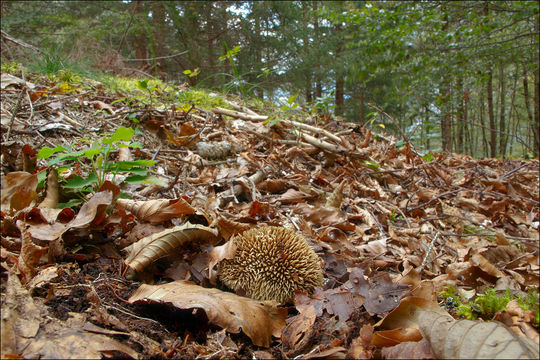Imagem de Lycoperdon echinatum Pers. 1794

Descrição:
Slo.: jeasta pranica - syn.: Lycoperdon gemmatum var. echinatum (Pers.) Fr., Lycoperdon hoylei Berk. & Broome, Utraria echinata (Pers.) Qul. - Habitat: old mountain Fagus sylvatica forest with some Picea abies, south inclined mountain slope, calcareous ground, warm and relatively dry place, in shade, under a Fagus sylvatica tree, partly protected from direct rain by tree canopies, average precipitations ~ 3.000 mm/year, average temperature 5-7 deg C, elevation 1.025 m (3.350 feet), alpine phytogeographical region. - Substratum: forest ground, organic debris on soil, mostly Fagus sylvatica leaves and Picea abies needles. - Comments: It is generally easy to recognize members of the genus Lycoperdon, although some species of genus Handkea, Vascellum or Scleroderma may cause confusion. The shape of their fruit bodies is more or less pear like and kids know very well they expel 'smoke' if they touch mature fruit bodies. However, to determine them on species level is more difficult. For example: If substrate is buried in the ground Lycoperdon pyriforme (which grows on wood) can easily be confused by Lycoperdon perlatum (which grows on soil); an old already brownish Lycoperdon perlatum can appear quite similar to Lycoperdon molle. etc. Neither shape nor color or surface of sporocarps or other individual morphological traits are reliable. All these vary significantly during life span of sporocarps and growing conditions. Only after gathering experience based on several finds in different conditions it gradually becomes easier to recognize them. Lycoperdon echinatum is an exception in this regard. Its sometimes up to 5 mm long spines covering the surface of the fruit bodies and distinctly brown color almost from the beginning of their development make the determination easy. - Growing solitary, fruit body diameter 4.8 cm (spines included), stem-like base height 1.8 cm, diameter about 1.5 cm; spines up to 3 mm long, partly solitary and partly two to four fused at the top; SP and mature gleba brown-gray with slight purple-lilac tint, oac638 (but darker). - Spores coarsely warty. Dimensions: 4,4 [4,9 ; 5] 5,5 x 4,3 [4,7 ; 4,9] 5,3 , Q = 1 [1,0] 1,1; N = 37; C = 95%, Me = 4,9 x 4,8 ; Qe = 1. Olympus CH20, NEA 100x/1.25, magnification 1.000 x, oil. AmScope MA500 digital camera. - Herbarium: Mycotheca and lichen herbarium (LJU-Li) of Slovenian Forestry Institute, Vena pot 2, Ljubljana, Index Herbariorum LJF - Ref.: (1) Leg.: Jernej Trnkoczy (2) R.M. Daehncke, 1200 Pilze in Farbfotos, AT Verlag (2009), p 1087. (3) R. Lueder, Grundkurs Pilzbestimmung, Quelle & Meyer (2008), p 326. (4) R. Phillips, Mushrooms, Macmillan (2006), p 328. (5) S. Buczacki, Collins Fungi Guide, Collins (2012), p 430. (6) J. Breitenbach, F. Kraenzlin, Eds., Fungi of Switzerland, Vol.2. Verlag Mykologia (1986), p 390. (7) G.J. Krieglsteiner (Hrsg.), Die Grosspilze Baden-Wrttembergs, Band 2., Ulmer (2000), p 142.
Incluído nas seguintes páginas:
- Life
- Cellular
- Eukaryota (Eucariontes)
- Opisthokonta
- Nucletmycea
- Fungi
- Dikarya
- Basidiomycota
- Agaricomycetes
- Agaricales
- Agaricaceae
- Lycoperdon
- Lycoperdon echinatum
Esta imagem não aparece em nenhuma coleção.
Informação de origem
- licença
- cc-by-nc-sa-3.0
- direitos autorais
- 2014 Dr. Amadej Trnkoczy
- fotógrafo
- Dr. Amadej Trnkoczy
- original
- arquivo de mídia original
- visite a fonte
- site do parceiro
- CalPhotos
- ID


